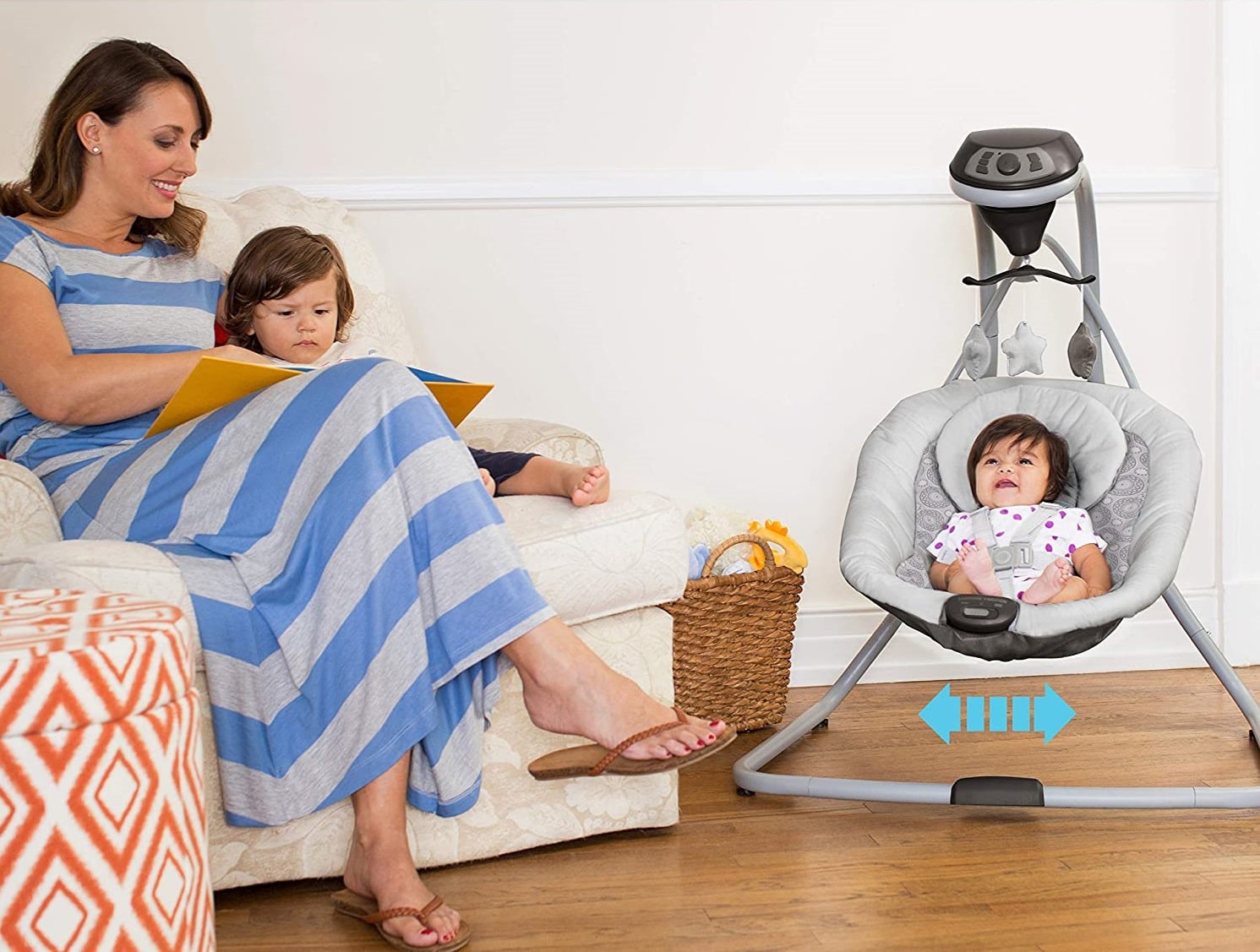Bringing home a baby is a special time. It’s full of love, little cries, and very little sleep. Many parents use a baby swing, like a Graco, to help calm their baby and get a short break.
But before you use the swing, you may have a question: When is it actually safe to use a Graco swing?
Most Graco swings are safe to use from birth, as long as your baby weighs at least 5.5 pounds and fits comfortably with proper head and neck support. It’s always a good idea to check your swing’s manual for the exact weight and age limits, since every model is a bit different.
This post will guide you through:
- What age, weight, and size is safe for the swing
- Signs your baby is ready
- How to use it safely
- And when it’s time to stop
Let’s help your baby enjoy the swing—and keep things safe and simple for you too.
In This Article
What Are the Age, Weight, and Height Limits?
Not every baby grows the same, and not every swing fits every baby. That’s why you should always check the weight and height limits before using your Graco swing. Because each Graco model has its own rules for weight and size.
Most Graco swings work for babies from birth if they weigh at least 5.5 pounds. That’s about the same as a small bag of sugar.
Wondering when it’s safe to start using it? As soon as your newborn hits the weight mark, you’re good to go. Graco swings are made to hold babies from 5.5 up to 25 or 30 pounds, depending on the model.
How long can you keep using it? Easy. Use it until your baby gets too big, too tall, or too active. If your baby tries to sit up, lean forward, or climb out—game over. That’s your cue to stop.
So what’s the weight limit for Graco swings? Most models top out at 25 to 30 pounds. Some may stop lower. Check the label on your swing for the exact number. It’s usually on the bottom or side of the frame.
When should you stop using the swing? Stop when:
- Baby hits the weight limit
- Baby gets too tall for the seat
- Baby starts sitting up or rolling over
Think of it like baby shoes—when they stop fitting, it’s time for a change. The swing is no different. It’s great while it lasts, but it won’t last forever.
Is My Baby Ready for the Swing?
Some babies love the swing from day one. Others need a little time. So how do you know if your baby is ready? Start with a simple check: can your baby lie back comfortably and stay still for a few minutes?
If your baby weighs at least 5.5 pounds, lies flat without slumping, and fits in the seat with their head supported—they’re good to go. That’s your green light.
You don’t need your baby to hold their head up fully. Most Graco swings come with head and neck support built in. But your baby should look calm, not curled up or twisted. If they slide down or look squished, it’s not the right fit yet.
Worried about milestones? Don’t overthink it. Your baby doesn’t need to smile, roll over, or coo on cue to use the swing. What matters most is size, comfort, and safety.
If you’re asking, “What should my baby be able to do before using it?”—here’s the short answer: they should lie still, breathe easy, and fit the seat. That’s it. No circus tricks needed.
Still unsure? Watch how your baby reacts. If they seem relaxed and quiet when the swing starts, they’re ready. If they fuss, flail, or look uncomfortable, try again later.
Some babies need a few days. Others take to it like ducks to water. Either way, let your baby lead the way. You’ll know when it feels right.
How to Use the Swing Safely
A baby swing should feel like a cozy hug—not a wild ride at the fair. It’s meant to comfort, not entertain. To keep things safe and simple, follow a few basic rules every time your baby goes in.
Always use the harness. It’s not optional. That strap keeps your baby from slipping or tipping, even if you’re just a few feet away. Buckling in takes seconds and makes a big difference. Place the swing on a hard, flat surface like your living room floor. Never set it on a bed, rug, or anything soft. Soft surfaces can make the swing unstable or even cause it to tip.
Time matters too. Most pediatricians recommend limiting swing use to 30 minutes at a time. That gives your baby a chance to relax, but not long enough for deep sleep or long-term lounging. Swings are made to soothe, not to replace cribs or bassinets. If your baby dozes off in the swing, gently move them to a safe sleep space.
And no, you shouldn’t leave your baby alone in the swing—not even for a quick chore. Things can change fast with little ones. They can shift, wake suddenly, or slide into an unsafe position. Always stay nearby where you can see and hear them.
Before each use, give the swing a once-over. Check for cracks, loose screws, or broken parts. If the swing is secondhand or older than your toddler’s tablet, look up the model and check for safety recalls. Manufacturers often update safety features or flag older versions.
Here’s a quick reminder list to keep swing time safe:
- Always use the harness to keep baby secure
- Place the swing on a flat, hard floor—never soft or uneven surfaces
- Never leave your baby alone in the swing
- Keep swing time under 30 minutes
- Don’t use the swing for naps or overnight sleep
- Move baby to a crib if they fall asleep
- Check the swing for wear, damage, or recalls
- Stop using it once your baby outgrows the weight or starts to sit up
Safe swing use isn’t complicated. Just keep things short, secure, and supervised. A little care goes a long way.
Can My Baby Sleep in a Graco Swing?
Many babies drift off while swinging, and it’s easy to think—just let them sleep, right? But the truth is, swings are not made for sleep. It’s not safe to let your baby nap or sleep overnight in a Graco swing. If they fall asleep, gently move them to a crib or bassinet. That’s the short answer, and it’s the one doctors trust.
Swings help soothe fussy babies, but they aren’t built for long rest. When your baby sleeps sitting up or reclined, their head can tilt forward. This makes it harder for them to breathe. That’s why the American Academy of Pediatrics says babies should always sleep on a firm, flat surface. No exceptions.
If your baby dozes off in the swing—which happens often—don’t panic. Just pick them up and lay them flat on their back in a crib, play yard, or bassinet. Let the swing do its job during wake windows, but when sleep comes, change the setup.
It may seem easier to let them stay put when they finally relax, especially if you’re tired too. But even short naps in the swing carry risks. It’s just not worth it.
So, can your baby sleep in a Graco swing? No. It’s meant for awake time only. For safe sleep, always move your baby when they nod off.
Keeping baby safe doesn’t need to be complicated. Just remember: soothe in the swing, sleep in the crib.
When to Stop Using the Swing?
Babies grow fast, and swings don’t stretch. One day, your baby will outgrow it—and when that day comes, it’s important to know. If your baby tries to sit up, lean forward, or roll to the side while swinging, it’s a clear sign it’s time to stop using it.
Most baby swings have a weight limit printed right on the frame or in the manual. For many models, the cutoff is somewhere around the size of a large watermelon—roughly 25 pounds. Once your baby crosses that mark or starts moving more like a toddler than a newborn, it’s time to say goodbye to swing time.
So, what are the signs it’s time to stop using the swing? The short answer: stop when your baby becomes too strong, too tall, or too squirmy. If they can sit up without help or try to climb out, the swing is no longer safe.
Can older babies still use swings? Only if they’re within the size limit and still calm in the seat. If your little one is kicking, twisting, or trying to escape, the swing isn’t the right fit anymore.
Even if the swing still looks solid, it’s made for a stage that doesn’t last long. As your baby grows into their next phase—rolling, crawling, standing—they’ll need more space and support than the swing can offer.
Let the swing do its job while it can, then retire it proudly. It helped when you needed it most—and now it’s time to move on.
Quick Tips for Parents
Every baby is different, and so is every day. Some days the swing feels like magic, other days it’s not enough. The key is to use it with care, pay attention to your baby’s cues, and follow a few simple habits. Baby swings aren’t complicated—but they do come with boundaries. A few smart steps can help you get the most from it while keeping your little one safe and comfy.
- Use the swing for short, calm sessions—not long naps
- Always buckle the harness, even for quick use
- Stay nearby while your baby is swinging
- Stop using the swing when baby starts sitting up or rolling
- Check weight and height limits regularly
- Never place the swing on soft or uneven surfaces
- Keep the swing clean and inspect it for damage
- Follow your baby’s mood—if they hate it, try again another time
Let your instincts guide you, and the swing can be a helpful tool—not a hassle.











